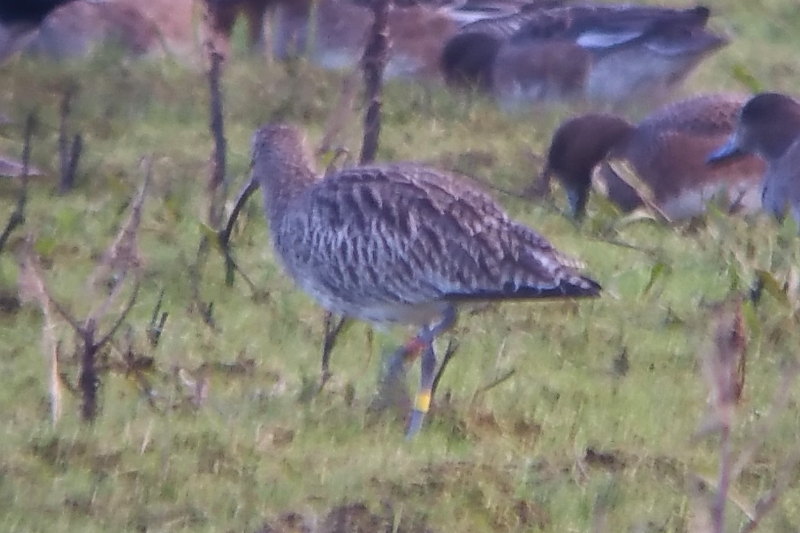I a colour-ringed Curlew at Rostaff Turlough near Headford yesterday just across the county border on the Mayo side. I got word very promptly back from Alan Leitch, David Douglas and Jenny Weston all of the RSPB this morning.
It was ringed as a chick near Corgarff within the Cairngorms National Park, Scotland in 2014. Amazingly it was part of a clutch of six chicks. As most of you will know, waders as a general rule nearly always lay four eggs so six is most unusual. Jenny believes the extra two chicks may actually be from another clutch entirely and were adopted as it were by another pair. You learn something new everyday! Thanks to Jenny Weston for the use of the photo.
This is the second Irish resighting from the Scottish scheme with a bird also ringed in the same area and year being seen in Dublin last March. http://grampianringing.blogspot.co.uk/2015/03/a-curlew-sighting-at-last.html
 |
| Add caption |
I also had a decent flock of 28 Greenland White-fronted Geese at
Rostaff. A few noteworthy birds at nearby Belclare Turlough back across on
the Galway side of the border as well. There was a very good sized flock of
around 54 Greenland White-fronts feeding in adjacent feeds. Great to see a few
family parties in amongst the flock. On the turlough itself I had a female
Ring-necked Duck mostly asleep with Pochard on the Belclare village side of the
lough. This is probably the first female I've seen in Galway in a few years
now. In my experience female Ring-necked Ducks seem to have a greater
tendency for associating with Pochard flocks over Tufted Duck. I suppose female
Ring-necks do have a closer resemblance to female Pochard over female
Tufted Duck. There seemed to more than the usual number of Pochard present
(50 birds) so in my continuing search for a Redhead and/or Canvasback I came
across a new hybrid combo for myself in the form of a male Red-crested Pochard
by Common Pochard. It immediately drew attention in having much cleaner white
flanks contrasting with a (darker) browner upperparts including brown
primaries, a hint of the puffy head shape of RC Pochard with orange on the
forehead, less black on the bill with a pink subterminal band and generally
being a slightly bigger bird compared to Common Pochard. It's a very close match to the second hybrid depicted in the link below.
https://www.flickr.com/groups/444365@N25/discuss/72157604053970163/
 |
| Male Red-crested Pochard x Common Pochard |
 |
| Male Red-crested Pochard x Common Pochard |
 |
| Male Red-crested Pochard x Common Pochard |
 |
| Male Red-crested Pochard x Common Pochard |
 |
| Male Red-crested Pochard x Common Pochard |
 |
| Female Ring-necked Duck |
 |
| Female Ring-necked Duck |
 |
Female Ring-necked Duck
|
To finish up the day I headed out to Tawin Island to look for the Pacific Diver that was discovered here nearly over month ago now. Between one thing and another, mainly extremely rough weather, I hadn't had a chance to look for this bird since being refound by Paul Troake this year. This is most likely to be the same bird initially found here in 2009. It's been seen very sporadically here and at Rinville Point and at Finvarra Point which is just across the border in county Clare. Paul almost certainly had this bird last winter but the views were just too distant to confirm it. HIgh tide may be best for bringing the bird in closer to shore. I spent a good three hours trying to see the bird yesterday. It has been seen mostly along the northern side of the headland but I saw it directly west off the headland and unfortunately was rather distant. If it was tick for me I mightn't have been able to tick due to the poor views however as I saw plenty in California this time last year I was happy enough to add it finally to my county list. There less than twenty Great northern and around five Red-throated Divers present. The sea was reasonably settled but a biting northerly wind made conditions on the side of the headland a bit nippy! Most of the divers were distant as it was at low tide at the time. It's amazing how quickly you can call Great northern Divers at huge distance. It's hard to put into words but its just down to the jizz I suppose. This bird clearly wasn't a GND nor a RTD for that matter. The only other possibility was Black-throated Diver but this bird at no time display the characteristic white thigh patch of that species. The cheek/face area seemed darker compared to BTD. One feature which I found also rather useful was the sublime and very distinctive gentle curvature of the head and neck. The nape area seemed much fuller but I didn't get the pale grey colour that's often seen in Pacific but again may have been due to the distant and light. It was also preening at one stage and was rolling onto it's side. Had it been closer in one would imagine that the vent strap would have been seen but alas no.












No comments:
Post a Comment